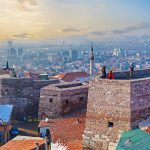
Just as the Kingdom of Saudi Arabia lacks a historical precedent, its capital city of Riyadh is a modern-day creation born of oil revenues and Saudi aspirations. For much of its history, what is now Riyadh was a loose collection of small oasis settlements overshadowed by the larger, wealthier, holier cities of Mecca and Medina (with Jeddah the main port of entry). Fortunes changed in the late 18th century, when the family of local religious leader Mohammad ibn Abdel Wahhab formed an alliance with the leader of a nearby town, Muhammad ibn Saud. The rest, as the say, is history. Even so, Riyadh did not have much going for it until the oil industry began booming. Now a city of more than 5 million inhabitants, Riyadh’s total population in 1950 was only about 100,000 people. Fueled by its dual position as the seat of the House of Saud and the national capital, the royal family and the government continue to dominate the local economy – Jeddah remains in many ways the commercial capital of the Kingdom, and the oil industry is in the Eastern Province. As with many Arab capitals in the Gulf, Riyadh’s newness is evident in its skyscrapers—large, flashy, and expensive while having little footing in history. The Kingdom Centre tower dominates the capital’s skyline, with much of the space housing a luxury hotel and a high-end shopping mall. The tower is the face of the rapidly expanding capital and the Saudi royal family’s attempts to craft a modern metropolitan city and a national identity in the middle of the desert.
For more on Saudi Arabia’s future, see Chapter 9 of The Accidental Superpower and Chapter 7 of The Absent Superpower.




